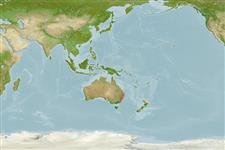Elasmobranquios (tiburones y rayas) (sharks and rays) >
Myliobatiformes (Stingrays) >
Urolophidae (Round rays)
Etymology: Trygonoptera: Greek, trygon = a sting ray + Greek, pteron = wing, fin (Ref. 45335).
More on authors: Müller & Henle.
Environment: milieu / climate zone / depth range / distribution range
Ecología
marino; salobre demersal; rango de profundidad ? - 135 m (Ref. 9863), usually ? - 60 m (Ref. 9863). Temperate; 26°S - 38°S
Western Pacific: southern Queensland to New South Wales.
Length at first maturity / Tamaño / Peso / Age
Maturity: Lm ?, range 41 - 42.7 cm
Max length : 47.0 cm TL macho / no sexado; (Ref. 9863)
Found in sandy beaches and reefs but also well offshore. May venture well upstream in estuaries (Ref. 6871). Feeds on worms, crustaceans, bony fishes, and other stingarees (Ref. 12951).
Life cycle and mating behavior
Maturities | Reproducción | Spawnings | Egg(s) | Fecundities | Larva
Compagno, L.J.V., 1999. Checklist of living elasmobranchs. p. 471-498. In W.C. Hamlett (ed.) Sharks, skates, and rays: the biology of elasmobranch fishes. Johns Hopkins University Press, Maryland. (Ref. 35766)
IUCN Red List Status (Ref. 130435)
Threat to humans
Harmless
Human uses
Herramientas
Special reports
Download XML
Fuentes de Internet
Estimates based on models
Preferred temperature (Ref.
123201): 17.1 - 24.1, mean 18.2 °C (based on 40 cells).
Phylogenetic diversity index (Ref.
82804): PD
50 = 0.5156 [Uniqueness, from 0.5 = low to 2.0 = high].
Bayesian length-weight: a=0.00813 (0.00366 - 0.01807), b=3.08 (2.88 - 3.28), in cm total length, based on LWR estimates for this (Sub)family-body shape (Ref.
93245).
Nivel trófico (Ref.
69278): 3.8 ±0.59 se; based on food items.
Resiliencia (Ref.
120179): Bajo, población duplicada en un tiempo mínimo de 4.5-14 años (Assuming fecundity<100).
Fishing Vulnerability (Ref.
59153): Moderate vulnerability (37 of 100).
Nutrients (Ref.
124155): Calcium = 7.7 [1.1, 139.9] mg/100g; Iron = 0.255 [0.025, 2.936] mg/100g; Protein = 20.1 [14.8, 25.3] %; Omega3 = 0.43 [0.13, 1.30] g/100g; Selenium = 8.78 [1.70, 44.63] μg/100g; VitaminA = 9.32 [0.81, 102.75] μg/100g; Zinc = 0.528 [0.041, 5.686] mg/100g (wet weight);
